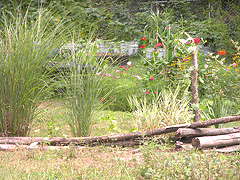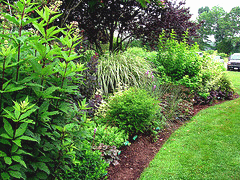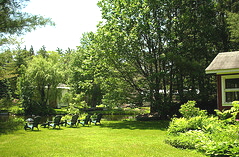How Far Apart
How far apart should I plant hedge plants? shrubs? roses? hedge and shrub roses? perennials? ornamental grass? trees?
This is a common question for all gardeners even when they know, in theory, how far apart to space plants. Everyone wants an easy answer, but there are many things to consider including personal preference. What effect do I want to create? How big will the plant really grow? What is the standard spacing? What is best for the health of the plant? And patience is always required! If you achieve the density you prefer in a few years, chances are your planting will be come seriously crowded and overgrown.
The first thing you need to know is the expected mature width of the plant, which is usually given as a range such as 3 to 5 feet wide. That is not very helpful if you want to achieve a specific effect, such as a dense hedge. So first consider the factors that may affect the growth of the plant. For example:
A heat loving plant that is hardy to zone 4 and is recommended for zones 4-8, may not get as large in zone 4.
A cold loving plant may not get as large in zone 8 as it would in zone 4, even if it tolerates the heat.
A plant that prefers full sun will not get as large in part shade.
Plants growing widely spaced from each other may spread wider than average.
Plants growing closely together in a mass may grow taller and not as wide.
Plants growing in adverse conditions may not grow as tall or wide as suggested. These conditions may include too much or too little sun, water, humidity or nutrients; soil pH too high or too low; exposed to high winds, high salt content of air or soil, pollution or other urban conditions that the plant is not tolerant of.
Plants growing in ideal conditions often grow larger that suggested.
General guidelines for spacing plant types: (note that how far apart to plant refers to the distance between the center of each plant, commonly referred to as “center to center”.
How far apart to plant roses
First, note that roses planted in cold climates, zones 5 and north, generally do NOT grow as large as they would in warmer climates. The exceptions may be the extra hardy Canadian roses and Rugosa roses.
Grandiflora and Tea roses are generally planted 24 to 30 inches apart producing a “massed” appearance and creating visual impact. Planted more than 30 inches apart will separate them enough that they become individual “specimens”, which may be desired for a single rose set apart from a shrub grouping, or for a group of three. A bed of roses all planted more than 30 inches apart does not give the eye a “place to rest” or a “path to follow”, making it difficult to enjoy looking at. Conversely, a bed planted too close together will inhibit the growth of individual plants, make it difficult to access plants for pruning and care, and restrict air circulation necessary to inhibit blackspot and mildew.
How far apart to plant shrub roses
As the selection of easy care shrub roses continues to expand, these carefree plants are being used as specimen or accent plants, foundation plantings, mass plantings, border gardens and hedges. Spacing becomes a matter of personal preference and the affect you want to create. Many of these hardy roses are highly resistant to blackspot, mildew and fungus, so they can be planted much closer together than the finicky hybrid tea roses and floribundas. Some don’t even need pruning other than occasionally removing damaged or dead canes, so you don’t need to be quite as concerned about making your way through the thorny branches. But do allow the beauty of the shrub to show itself off by giving it a little room, a mass planting should be spaced the full width of the mature shrub. Hedges can be planted a bit closer, reducing the spacing up to one forth.
How far apart to plant shrubs and bushes
Shrub roses, deciduous shrubs, and evergreen shrubs should be planted as far apart as the mature width. When they have reached full size, in theory they will end up “side by side” without gaps or overlap. If you would like to allow space to walk between or allow separation space, space the plants an additional 24 inches apart. If you prefer a dense “full” garden look, plant slightly closer together so the plants fill into one another when the have reached full size.
How far apart to plant a hedge
A hedge may be created from literally any plant you choose. Use evergreen or deciduous shrubs, shrub roses or even grandiflora or tea roses. (Close spacing of roses in a single line hedge allows enough air circulation on two sides and access for care from front and back.) What might be considered a “standard” hedge is planted so the plants at full size will be side by side. So 4 foot wide plants are planted 4 feet apart. To create a denser hedge with a more “continuous” look, plant 4 foot wide plants 3 feet apart. Although they could be planted even closer together to form an impenetrable barrier, the growth and health of the plant may be inhibited if you plant closer that half the full grown width. A better solution may be to plant two staggered rows. They can then be planted with about a 25% overlap side to side and front to back, forming a dense barrier
How far apart to plant a screen
A screen of plants to provide privacy or block an undesirable view can be created from any plant you choose. Generally screens are created with tall plants including large deciduous or evergreen shrubs, taller evergreen trees, deciduous trees or even ornamental grass. Use the same guidelines as for hedges, but keep in mind that generally the large and tall plants grow at a slower rate than shrubs and will take longer to form a dense screen.
A privacy screen can often be created by using plants that spread wide with an open structure so as not to create a dense shade but still provide some privacy. Large shrubs that are not pruned frequently will typically not grow as dense and will spread wide fairly quickly. Ornamental grass can screen and be visually very light and airy. Small ornamental trees, or even larger shade trees, that are not pruned high up the trunk can provide lovely screening for a raised patio or a deck. Ornamental trees such as hydrangea, Japanese maple, crepe myrtle and magnolia grow with a shrub like structure if left unpruned. Trees used for screening should be spaced using the full mature width of the crown.
How far apart to plant ornamental grass
Ornamental grasses grow either in clumps or they spread by underground rhizomes. The spreaders can sometimes take over areas quite aggressively. When selecting a grass be sure you get one that will behave the way you want it to. A spreading grass may be ideal to expand through a large area, or to fill a contained area. Otherwise a clump grass is more predictable and easier to control. To take full advantage of the movement of grasses in the breeze and to show off their distinctive forms, ornamental grass should be spaced as far apart as they grow tall. For groupings and mass plantings that will give you the best effect. But grasses are being used in such a variety of ways that you may decide to space them much closer together if your intention is a light screening or border planting. You will still get a lot of movement from tall grasses as long as you don’t try to create a tightly planted dense screen.
How far apart to plant perennials
As with shrubs and roses, standard spacing is to allow the mature width for the plant to fill into. Perennials are also given a width range, so again consider your climate and growing conditions. Personal preference is once again important. If you prefer a fuller look in your garden and would like to achieve it quickly, you may be dividing overgrown perennials more quickly than you had hoped. A better solution might be to fill in the gaps with a few annuals until the perennial plants have reached their mature size.
Also consider air circulation with perennials that are prone to mildew or fungus. Allowing such plants plenty of room to mature without crowding will help minimize mildew and fungus problems. Also consider allowing room to access the plants to cut flowers, deadhead and fertilize. If you prefer the full look of tightly spaced plants, consider creating paths of stepping stones through the gardens for easy access.
How far apart to plant a windscreen
First, be aware that this can be a little tricky. If you want to block heavy winds or cold north winds from your home or gardens, first be sure of the direction of the most offending winds. Generally they will come from the North or Northwest. The wind is blocked most effectively for a distance of about six times the height of the plants. So for a while the wind diversion will only affect a small area until the plants reach maturity. If you need to block intense or damaging winds on a very exposed site, the plants you select should be dense. Evergreens are dense, available from 6 to 60 feet, and will protect all year. They can be planted to overlap substantially, reducing the space between by at lease 25% of the mature width. Or plant two rows to fill the gaps between. Deciduous trees can provide an effective windbreak when shrubs are planted in front of the row of trees. This also creates a more interesting effect, rather than just creating a wall of evergreen. Combinations of evergreens, deciduous trees and shrubs can also be very effective while creating more interest in the landscape.
How far apart to plant trees
Trees should nearly always be planted to allow the full width of the mature canopy. This also prevents competition in the roots, which generally spread as wide as the canopy. Since trees are sometimes used to screen a view or winds, they can be spaced slightly closer together. But trees planted closer together will grow taller competing for sunlight, so planting trees to closely will somewhat reduce the canopy width anyway. Plant to overlap no more than 10 to 25% of the mature canopy width.
Figure out the look you prefer before deciding how far apart to space your plants. But do pay attention to the recommendations that come with your plant to ensure healthy growth.














